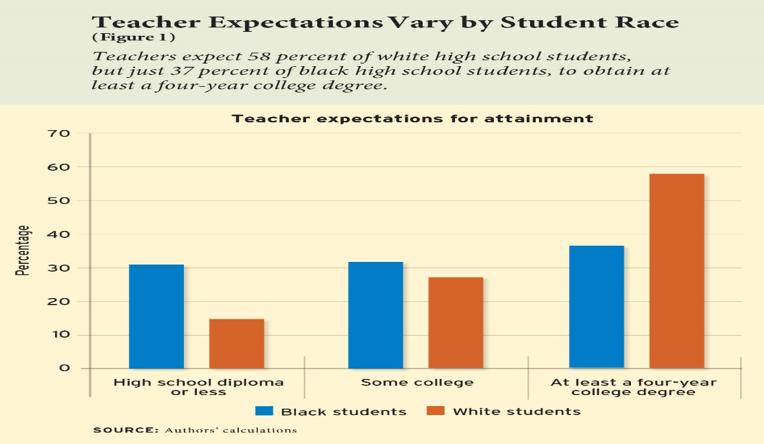Are Expectations Really Based on Color?
As a first generation Haitian American, I was always clumped in the African American category. It was difficult for me to understand early on because most of my early childhood I mainly interacted with Haitian family and friends. Therefore, I basically accepted being called African American. Unfortunately, the stigma of low expectations that is closely associated with being a Black person, especially a Black male has developed so many stories since my youth that I have to share. However, I wanted to get a parent to tell me a story about the inequities in education for their child of color. In my pursuit to find stories of inequities in the form of low expectations for students of color, I didn’t have to look far. Someone that I consider a dear friend, Jennifer Minaya-Osemwegie was excited to tell her story. Mrs. Minaya-Osemwegie is the Director of Community Education for the South Brunswick Public Schools in South Brunswick, New Jersey and a GOMO consultant. She is a first generation Dominican American and her husband is Nigerian.
Mrs. Minaya-Osemwegie recounts, “When my son was in elementary school he excelled in math. He never scored lower than a 95 on any assignment, did mental math faster than my husband and I, and was recognized for three consecutive years as he received a perfect score on the math NJASK assessments. When we received his placement letter for math as he entered intermediate school, I was shocked to find out he was placed in a remedial math class. I assumed this was a simple oversight. How could a child slated for gifted and talented be scheduled into remedial?

In September, I made an appointment to discuss his placement. I was told to first speak to the teacher and so I visited the school and went to the remedial class. I found my son helping the other students. The teacher commented and praised him for working so well with his peers and being her assistant. I asked her why she thought he should be in the class if he had mastered the skills the class was supposed to address. She responded that she had nothing to do with placement and that I needed to speak to the administration. As I walked down the hall, I looked into both the regular math class and the gifted and talented class. I continued to the main office and scheduled another appointment. I had to wait three weeks for the assistant principal’s schedule to accommodate me.
On the day of the appointment, my husband and I waited in the main office to speak to the assistant principal who was running late. After waiting for 20 minutes she rushed us into her office and asked us whose parents we were. I advised my son’s name and reminded her we were there to discuss his placement in the remedial class. She cut me off, saying that all placements were final and that multiple measures were used for placement. I asked her to explain what measures these were. She sighed and began speaking slower “multiple measures means we use different information to put students into the classes they belong”. I asked if she could let me know what information had been used to place my son into this remedial class. She informed me that they used state test scores, report card grades, discipline records and teacher recommendation. She again repeated that all placements were final and that she had another appointment she was late to.
I smiled, and then explained to her that I was also an assistant principal and that I also used these exact same criteria when placing students at my middle school. She looked up from her desk as I pulled five years of report cards, three years state scores, the certificates and pictures with the teacher and principal for three years of perfect scores, his good citizens awards, perfect attendance awards and a card from his last teacher that discussed his recommendation for my son to go into the gifted and talented program at the intermediate school.
The assistant principal was at a loss for words. She shook her head and exclaimed “There must be some mistake”. I stood, gathered the documents, picked up my bag and signaled to my husband. I advised her that the only mistake was that the class I had visited was 100% children of color in a district where black and brown students accounted for only 20% of the population. I also noted that the gifted and talented class that I had seen as I walked down the hall that day, had no children of color. She assured me that she would speak to the math supervisor to see what she could do and that I just needed to fill out a transfer of class form. I looked at her, shook my head and informed her that the only form I needed was a withdrawal form because my son was going to an independent school.
Not only had I had to wait over a month and a half to rectify my son’s placement, I had to endure her lateness and attitude and had to justify what should have been a given and what the other white parents in gifted and talented did not have to defend.”
This is why the work of GOMO Educational Services is so important for school and district leaders. It is imperative that the leaders recognize and tackle the implicit and explicit bias that permeates the educational system. Equally important they must become aware of the micro and macroaggressions that are delivered daily to students of color and different backgrounds. Districts must change their practices and understand the root causes that lead them to automatic assumptions towards students of color and different backgrounds and their families. These assumptions include that parents of color and different backgrounds are ill equipped to understand school policy and procedures, that they are subpar and that their children do not deserve what is rightfully theirs, an equal opportunity to the American Dream.
I guess that some people of the dominant race and culture believe that they and anyone they grant access has the right to this dream. Imagine if Mrs. Minaya-Osemwegie didn’t come prepared with all of her son’s data, report card and letters and told this assistant principal that she was not only equally educated but held the same role. It would have been a different story for her and her child. Today, Mrs. Minaya-Osemwegie notified me that her son attends a prestigious private school in Princeton, New Jersey that challenges him to be even better as a student and human being. Educational leaders are you leading an organization with oppressive practices and procedures that saliently or delicately contradicts the organization’s proposed belief of all students and their potential? If yes, what steps are you taking for your organization to become anti-racist or anti-oppressive? Remember, you are not alone in this pursuit. Here are some simple and quick steps leaders can take immediately in their organizations.
- Speak to the staff and students of color and different backgrounds in your organization and ask about their experiences like treatment, academic and behavioral expectations, voice, access, procedures, etc.
- Conduct a minor audit around the areas discussed with the staff and students of color and different backgrounds for inequities
- Bring together a team of various stakeholders that seek to make and see real change in policies, procedures and practice. Create an action plan from the system down to the classroom and activities for the community to engage in.
- Find out what your neighboring schools and organizations are doing or search on social media to get ideas from people around the world.
- Seek out other organizations that are really grounded in the work for short-term or long-term support.


